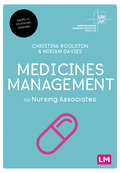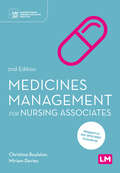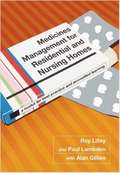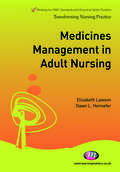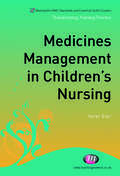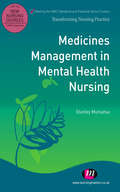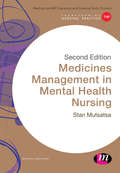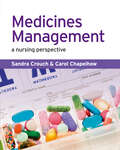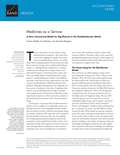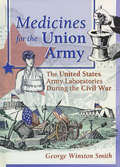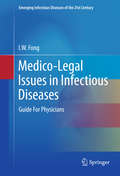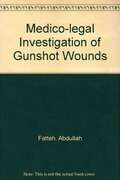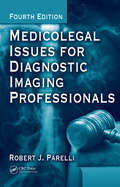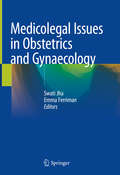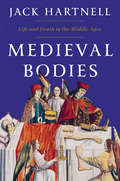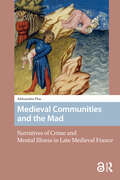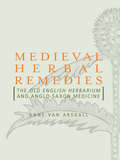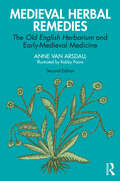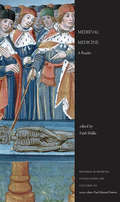- Table View
- List View
Medicines Management for Nursing Associates (Understanding Nursing Associate Practice)
by Christina Roulston Miriam DaviesThe first medicines management textbook for trainee nursing associates! Effectively managing and administering medicines is a core responsibility for all Nursing Associates. To help you master these skills, this book covers everything you will need to know in medicines management, from understanding the fundamental legal and professional requirements, to developing essential drug calculations skills. By breaking down this often-overwhelming subject into manageable chunks, the book guides you through it all, step-by-step, with the help of insightful case studies and activities. Key features: Fully mapped to the new NMC standards of proficiency for nursing associates (2018) Activities and other learning features help you get to grips with the key skills Wide-ranging case studies covering all fields and environments show how this knowledge applies to your practice. ABOUT THE SERIES: The Understanding Nursing Associate Practice series (UNAP) is a new collection of books uniquely designed to support trainee Nursing Associates throughout their training and into a professional career.
Medicines Management for Nursing Associates (Understanding Nursing Associate Practice)
by Christina Roulston Miriam DaviesThe first medicines management textbook for trainee nursing associates! Effectively managing and administering medicines is a core responsibility for all nursing associates. This book covers everything a trainee nursing associate needs to master, from understanding the fundamental legal and professional requirements to developing essential drug calculations skills. This often-overwhelming subject is broken down into manageable chunks, with students taken step-by-step through the theory before practicing what they’ve learnt with the help of insightful case studies and activities. Key features: Written specifically to address the unique experiences, challenges and requirements of the nursing associate role and fully mapped to the NMC standards of proficiency (2018). Activities help trainees get to grips with the key skills and responsibilities of the role and allow them to practice calculations. Wide-ranging case studies cover all fields and a variety of clinical settings to show how this knowledge applies to practice. ABOUT THE SERIES: The Understanding Nursing Associate Practice series (UNAP) is a new collection of books uniquely designed to support trainee nursing associates throughout their training and into a professional career.
Medicines Management for Nursing Associates (Understanding Nursing Associate Practice)
by Christina Roulston Miriam DaviesThe first medicines management textbook for trainee nursing associates! Effectively managing and administering medicines is a core responsibility for all nursing associates. This book covers everything a trainee nursing associate needs to master, from understanding the fundamental legal and professional requirements to developing essential drug calculations skills. This often-overwhelming subject is broken down into manageable chunks, with students taken step-by-step through the theory before practicing what they’ve learnt with the help of insightful case studies and activities. Key features: Written specifically to address the unique experiences, challenges and requirements of the nursing associate role and fully mapped to the NMC standards of proficiency (2018). Activities help trainees get to grips with the key skills and responsibilities of the role and allow them to practice calculations. Wide-ranging case studies cover all fields and a variety of clinical settings to show how this knowledge applies to practice. ABOUT THE SERIES: The Understanding Nursing Associate Practice series (UNAP) is a new collection of books uniquely designed to support trainee nursing associates throughout their training and into a professional career.
Medicines Management for Residential and Nursing Homes: A Toolkit for Best Practice and Accredited Learning
by Roy C. Lilley Paul Lambden Siddhartha GoelThis practical toolkit informs readers of ways to ensure the right medication in the right dose, for the right patient at the right time. It covers every aspect of looking after and delivering medicines in the care home environment. The easy-to-read format, with questions and exercises for individuals and groups, makes the text ideal as a framework for teaching and accredited learning. This handbook is vital for care professionals working in residential and nursing homes, their managers and supervisors. It is also invaluable for trainee care and nursing assistants including students in further education. 'When inspectors said thousands of care home residents were being given the wrong medication - the image of a grotty, poorly run nursing home reared its stereotypical head. How could something so simple as giving a patient their daily dose of tablets be going so wrong, so many times over? But according to care professionals, management of residents' medication is one of the most complex areas of running a nursing home, and unless fail-safe practices are adhered to, the results can be very damaging to both the resident and the care worker. Clearly, it's time to sort this out!' - Roy Lilley and Paul Lambden with Alan Gillies, in the Introduction.
Medicines Management in Adult Nursing (Transforming Nursing Practice Series)
by Dawn Hennefer Liz LawsonCorrect medicines management for adults is a crucial skill that adult nursing students must develop in order to provide safe care to their patients. This book specifically supports pre-registration students in meeting the required competencies for medicines management needed to pass formal assessment and qualify as an adult nurse. It is clearly structured around the NMC Essential Skills Clusters for medicines management, covering legal aspects, drugs calculations, administration, storage, record keeping, introductory pharmacology, patient communication and contextual issues in medication. The book is written in user-friendly language and uses patient scenarios to explain concepts and apply theory to practice.
Medicines Management in Children′s Nursing (Transforming Nursing Practice Series)
by Karen BlairChildren′s nurses must develop the crucial skills of correct medicines management and calculations in order to provide safe care to their patients. This book specifically supports pre-registration students in meeting the required competencies for medicines management needed to pass formal assessment and qualify as a children′s nurse. It is clearly structured around the NMC Essential Skills Clusters for medicines management, covering legal aspects, drugs calculations, administration, storage, record keeping, introductory pharmacology, patient communication and contextual issues in medication. The book is written in user-friendly language and uses patient scenarios to explain concepts and apply theory to practice.
Medicines Management in Mental Health Nursing
by Stanley MutsatsaMental-health nurses must develop the crucial skills of correct medicines management and calculations in order to provide safe care to their patients. This book specifically supports pre-registration students in meeting the required competencies for medicines management. It has a strong emphasis on understanding the role of medicine as one of a range of treatment options, and collaborative working with patients and carers. It is clearly structured around the NMC Essential Skills Clusters for medicines management, covering law, drugs calculations, administration, storage, record keeping, introductory pharmacology, patient communication and contextual issues.
Medicines Management in Mental Health Nursing (Transforming Nursing Practice)
by Stanley MutsatsaMedicines are a crucial part of the jigsaw when considering how to provide recovery-focussed care in mental health. It is important that mental health nurses understand how psychiatric drugs work, what the common treatments are and appreciate the ethical and legal dimensions that affect how medicines can and should be used in mental health care. Using innovative activities and real-life case studies, this book has been carefully designed to provide all this and more making it the ideal resource to build knowledge and confidence in this crucial area of practice. Key features · Clear explanations of both the underlying biology and pharmacology as well as the wider practicalities of working with medicines · Provides accessible information on the most common conditions and treatments · Linked to the NMC standards and essential skills clusters · Activities and case studies help students to apply what they have learnt to practice and consider the full impact that medicines will have on service users
Medicines Management: A Nursing Perspective
by Sandra Crouch Michael Crouch Carol ChapelhowMedicines Management: A Problem-Based Approach uses patient scenarios to explore pharmacology and medicines management. The book provides the pharmacological background, and examines the other factors, which enable nurses to provide care to the patient. It will equip the new nurse with the skills they need to problem-solve, prioritise and make decisions while delivering effective care.
Medicines Management: A Nursing Perspective
by Sandra Crouch Michael Crouch Carol ChapelhowMedicines Management: A Problem-Based Approach uses patient scenarios to explore pharmacology and medicines management.The book provides the pharmacological background, and examines the other factors, which enable nurses to provide care to the patient. It will equip the new nurse with the skills they need to problem-solve, prioritise and make decisions while delivering effective care.
Medicines as a Service: A New Commercial Model for Big Pharma in the Postblockbuster World
by Tewodaj Mengistu Soeren Mattke Lisa KlautzerThe pharmaceutical industry can reconfigure its considerable resources to develop innovative and meaningful business models that are based on services that improve access and adherence to prescription drugs for common chronic conditions. Such innovation beyond drug development is consistent with the core capabilities of large pharmaceutical companies and has the potential to achieve profit levels similar to those of its traditional models.
Medicines for the Union Army: The United States Army Laboratories During the Civil War
by Dennis B Worthen Greg HigbyIt wasn't only combat that killed during the Civil War!Among white Federalist troops alone, there were 1,213,685 cases of malaria, 139,638 cases of typhoid fever, 67,762 cases of measles, 61,202 cases of pneumonia, 73,382 cases of syphilis, and 109,202 cases of gonorrhea between May 1, 1861 and June 30, 1866. (Statistics for Negro troops covered less than three years of the Civil War period.)Preventative medicine at the time had little more to offer than quinine and a few disinfectants. There was no real understanding of the germ theory of disease. But Medicines for the Union Army: The United States Army Laboratories During the Civil War shows that in the evolution of the army's Medical Department from incompetence to general efficiency during this time, and in the vastly improved organization and supply system designed by William A. Hammond, Jonathan Letterman, the medical purveyors, and others working under the Surgeon General, there was evidence of a great achievement.In Medicines for the Union Army you will come to understand the medical purveying system of the time and its problems, and you will witness the birth, growth, and remarkable achievements of the Federal government's pharmaceutical laboratories at Astoria, New York, and Philadelphia, Pennsylvania.Medicines for the Union Army will inform and enlighten you about the these laboratories, including: the funding and transportation obstacles faced at the Astoria lab the processes by which raw materials became drugs ready for distribution drug testing and inspection methods the bottling of “medicinal whiskey” and wine at the labs the people whose work laid the foundation for modern drug production and distribution methods the contents of the medical supply cases (panniers) and wagons in use at the time . . . and much more!Medicines for the Union Army: The United States Army Laboratories During the Civil War brings to light the groundbreaking achievements of unsung American heroes working to preserve life while the country was in bloody turmoil. No Civil War historian should be without this volume!
Medico-Legal Aspects of Reproduction and Parenthood (Medico-Legal Series)
by J.K. MasonThose involved in family and sexual relationships today face a bewildering variety of medico-legal dilemmas. These are encountered from as early as the preconception state of the embryo and continue throughout the period of child raising until the status of the mature minor is achieved. This book dissects a wide range of legal, medical and ethical issues surrounding reproduction and the parental relationship with the resultant child. Questions posed in the various sections include: what constitutes sexual intercourse, what are the implications of contraception and sterilization, is the abortion issues dead?. Is there a right to reproduce and, if so, how is this applied to the modern methods of assisted reproduction?. Is surrogate motherhood acceptable or workable?. The concept of fetal rights is explored and specific attention is given to the management of defective neonates in the light of recent judicial decisions. Other chapters look at the parent/child relationship in respect of medical treatment and the book concludes with a review of the interfamilial protection of young children under both the civil and the criminal law. Many of the views expressed are novel in that they represent those of a medical doctor exploring the legal field. It is neither a conventional book on family law nor one on medical law; rather, it draws on both to examine a specific area which affects both in a particularly significant way. Both statute and case law have been extensively updated since the publication of the first edition.
Medico-Legal Issues in Infectious Diseases
by I. W. FongThe aim of this book is not to encourage defensive medical practice, but to help provide better, optimum care to patients and to be forth right and honest to our dear customers about our inevitable mistakes. This book will focus on clinical issues facing physicians in different settings (which can lead to malpractice), and the best approach to use to avoid litigations, and practice good medicine.
Medicolegal Investigation of Gunshot Wounds
by Adbullah FattehWas written by an expert who at the time was a D.M.E. a visiting professor of Pathology and a consultant to the Criminal Justice Institute at Fort Lauderdale, Florida. Clearly written and easily understood, the book deals with all aspects of medicolegal investigation of gunshot wounds and deaths.The duties and responsibilities of the medical investigators and the police are explicitly outlined and guidelines are established for co-operative efforts between the two. The investigation of homicides, suicides, and accidents involving firearms, including investigation of the scene of the injury or death.
Medicolegal Issues for Diagnostic Imaging Professionals
by Colin M. Howles Zeev Shoham Robert J. Parelli David. K WeissmanThe constant advances in diagnostic imaging have had an impact on the practice, attitudes, and moral values of all who participate in health care. Now in its fourth edition, the original Medicolegal Issues for Radiographers has been updated and retitled, broadening the scope of content to include issues essential to all diagnostic imaging pr
Medicolegal Issues in Obstetrics and Gynaecology
by Swati Jha Emma FerrimanThis book highlights minimum standards relating to the management of different conditions in the practice of Obstetrics and Gynaecology. The editors explore clinical governance issues, common causes of as well as ways to avoid litigation. The UK is experiencing a dramatic increase in medico-legal claims. The 4 main reasons for litigation are: accountability, the need for an explanation, concern with standards of care and compensation. However the decision to take legal action is determined not only by the original injury, but failure to provide information, an explanation and an apology. Insensitive handling of an injury and poor communication after the original incident increases the risk of litigation and erodes the patient-doctor relationship. Doctors almost never deliberately cause harm to patients, however increasingly claims are being defended successfully. This book is invaluable to clinicians and lawyers alike and raises awareness of how to avoid facing clinical negligence claims in our day to day practice.
Medienkompetenz bei Jugendlichen: Ein Guide für einen verantwortungsvollen Umgang mit Social Media, Gaming und Co.
by Kathrin HabermannSurfen, Zocken, Posten, Streamen Haben Sie sich schon einmal gefragt, was Snapchat eigentlich wirklich ist und wie Social Media Apps Geld mit Daten verdienen? Oder wie gefährlich Online-Games wirklich sind beziehungsweise, ob sie sogar Vorteile für die Entwicklung bieten? Worauf sollte man beim Thema Datenschutz konkret achten? Wie sieht eine gelungene Anleitung zum Umgang mit digitalen Medien aus? Wie kann man ChatGPT erfolgreich in den Schulalltag integrieren? Erfahren Sie in diesem Ratgeber für Eltern, Pädagog*innen und Therapeut*innen, was Jugendliche selbst über ihren Medienkonsum denken und welche Medienkompetenzen heute notwendig sind, um gesellschaftlich nicht den Anschluss zu verlieren. Aus dem Inhalt: Auswirkungen digitaler Medien auf Gehirnentwicklung, Konzentration und Suchtverhalten von Jugendlichen, Einsatz digitaler Medien in Schulen, Chancen und Risiken von Social Media und Gaming, Onlinehandel und Datenschutz, Richtlinien zur gesunden Screentime und Anlaufstellen für Eltern. Plus Material- und Spiellisten, Mediennutzungsvertrag und mehr zum Download und als Kopiervorlage. Diese 2. Auflage ist komplett überarbeitet und aktualisiert mit der neuesten Literatur und Studienlage.
Medienkompetenz bei Kindern: Ein Guide für einen verantwortungsvollen Umgang mit Smartphone, Tablet und Co.
by Kathrin HabermannDieser Ratgeber unterstützt Eltern, Pädagog*innen und Therapeut*innen dabei, die Faszination von Smartphones für Kinder zu verstehen, die Bedeutung von Langeweile zu erkennen und ihren Kindern einen verantwortungsvollen Umgang mit digitalen Medien zu vermitteln. Lernen Sie, wie Sie mit der ständigen Präsenz von Smartphones, Tablets und Co. gelassen und kreativ umgehen können und welche wissenschaftlichen Erkenntnisse zu diesem Thema relevant für die Entwicklung Ihres Kindes sind. Bieten Sie Kindern attraktive Alternativen und zahlreiche einfache Spiele für den täglichen Gebrauch. Entdecken Sie spannende und entwicklungsfördernde Aktivitäten, die wenig Material und kaum Vorbereitungszeit erfordern. Erhalten Sie Praxistipps für herausfordernde Situationen wie Restaurantbesuche, lange Autofahrten oder Bahnreisen. Nach diesem Ratgeber sind Sie bestens vorbereitet. Plus: Wissenschaftliche Hintergründe und aktuelle Studien übersichtlich und verständlich aufbereitet, Fragebögen und Checklisten zur Ermittlung des Medienkonsums, Material- und Spiellisten, Mediennutzungsvertrag und mehr zum Download und als Kopiervorlage.
Mediennutzung von Kindern und Jugendlichen: Abhängigkeitsstörung mit Potenzialen für eine Volkskrankheit (essentials)
by Manfred CassensSpätestens seit Ende der 1990er Jahre zeichnete sich über eine für normal befundene Nutzung des Internets eine Gruppe von stoffungebundenen Verhaltens- als Abhängigkeitsstörungen ab, die mit dem Internet in Verbindung gebracht werden. Dies sind: Computerspielen, die pathogene Nutzung sozialer Netzwerke, das Online Shopping und der Cybersex. Gegenwärtig (2023) ist jedoch lediglich das Computerspielen in das aktuelle Klassifikationsinstrument der Krankheiten, die ICD-11, aufgenommen worden. Aktuelle diagnostische Tools basieren dabei vor allem auf psychologischen Testmanualen und klinischen Abklärungsgesprächen. Dieses essential reflektiert die aktuelle Gesamtsituation auf Basis epidemiologischer Erkenntnisse und diskutiert darüber hinaus indizierte diagnostisch erweiterte Optionen.
Medieval Bodies: Life And Death In The Middle Ages (Wellcome Collection)
by Jack HartnellWith wit, wisdom, and a sharp scalpel, Jack Hartnell dissects the medieval body and offers a remedy to our preconceptions. Just like us, medieval men and women worried about growing old, got blisters and indigestion, fell in love, and had children. And yet their lives were full of miraculous and richly metaphorical experiences radically different from our own, unfolding in a world where deadly wounds might be healed overnight by divine intervention, or where the heart of a king, plucked from his corpse, could be held aloft as a powerful symbol of political rule. In this richly illustrated and unusual history, Jack Hartnell uncovers the fascinating ways in which people thought about, explored, and experienced their physical selves in the Middle Ages, from Constantinople to Cairo and Canterbury. Unfolding like a medieval pageant, and filled with saints, soldiers, caliphs, queens, monks and monstrous beasts, this book throws light on the medieval body from head to toe—revealing the surprisingly sophisticated medical knowledge of the time. Bringing together medicine, art, music, politics, philosophy, religion, and social history, Hartnell's work is an excellent guide to what life was really like for the men and women who lived and died in the Middle Ages. Perfumed and decorated with gold, fetishized or tortured, powerful even beyond death, these medieval bodies are not passive and buried away; they can still teach us what it means to be human. Some images in this ebook are not displayed due to permissions issues.
Medieval Communities and the Mad: Narratives of Crime and Mental Illness in Late Medieval France (Premodern Health, Disease, and Disability)
by Aleksandra Nicole PfauThe concept of madness as a challenge to communities lies at the core of legal sources. Medieval Communities and the Mad: Narratives of Crime and Mental Illness in Late Medieval France considers how communal networks, ranging from the locale to the realm, responded to people who were considered mad. The madness of individuals played a role in engaging communities with legal mechanisms and proto-national identity constructs, as petitioners sought the king’s mercy as an alternative to local justice. The resulting narratives about the mentally ill in late medieval France constructed madness as an inability to live according to communal rules. Although such texts defined madness through acts that threatened social bonds, those ties were reaffirmed through the medium of the remission letter. The composers of the letters presented madness as a communal concern, situating the mad within the household, where care could be provided. Those considered mad were usually not expelled but integrated, often through pilgrimage, surveillance, or chains, into their kin and communal relationships.
Medieval Herbal Remedies: The Old English Herbarium and Anglo-Saxon Medicine
by Anne Van ArsdallThis book presents for the first time an up-to-date and easy-to-read translation of a medical reference work that was used in Western Europe from the fifth century well into the Renaissance. Listing 185 medicinal plants, the uses for each, and remedies that were compounded using them, the translation will fascinate medievalist, medical historians and the layman alike.
Medieval Herbal Remedies: The Old English Herbarium and Early-Medieval Medicine
by Anne Van ArsdallFeatured here is a modern translation of a medieval herbal, with a study showing how this technical treatise on herbs was turned into a literary curiosity in the nineteenth century. The contours of this second edition replicate the first; however, it has been revised and updated throughout to reflect new scholarship and new findings. New information is presented on Oswald Cockayne, the nineteenth-century philologist who first translated the Old English medical texts for the modern world. Here the medieval text is read as an example of technical writing (i.e., intended to convey instructions/information), not as literature. The audience it was originally aimed at would know how to diagnose and treat medical conditions and knew or was learning how to follow its instructions. For that reason, while working on the translation, specialists in relevant fields were asked to shed light on its terse wording, for example, herbalists and physicians. Unlike many current studies, this work discusses the Herbarium and other medical texts in Old English as part of a tradition developed throughout early-medieval Europe associated with monasteries and their libraries. The book is intended for scholars in cross-cultural fields; that is, with roots in one field and branches in several, such as nineteenth-century or medieval studies, for historians of herbalism, medicine, pharmacy, botany, and of the Western Middle Ages, broadly and inclusively defined, and for readers interested in the history of herbalism and medicine.
Medieval Medicine: A Reader (Readings in Medieval Civilizations and Cultures)
by Faith WallisMedical knowledge and practice changed profoundly during the medieval period. In this collection of over 100 primary sources, many translated for the first time, Faith Wallis reveals the dynamic world of medicine in the Middle Ages that has been largely unavailable to students and scholars. The reader includes 21 illustrations and a glossary of medical terms.
